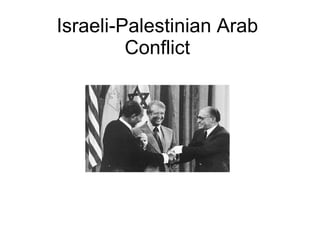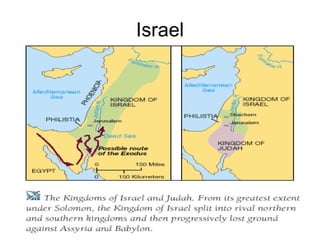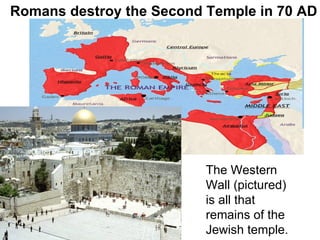Arab-Israeli Conflict Summary and Brief History
- 2. Roots of the Conflict
- 3. Israel
- 4. Romans destroy the Second Temple in 70 AD The Western Wall (pictured) is all that remains of the Jewish temple.
- 9. 1917-1947 “The Mandate Years” After WWI, the area had become the British mandate of Palestine. When Jewish immigration accelerated, friction was created between Jews and Palestinian Arabs After 1945, Zionists and Palestinian Arabs wanted individual nations and both felt they had claim to Palestine. Britain withdrew in 1947 and the U.N. proposed that the country be partitioned 50/50
- 11. War of Independence or the Catastrophe? A war broke out when the Jews, certain of U.S. and Soviet support, declared their independence and the creation of a new state of Israel on May 14, 1948. When fighting ended in 1949, the Israelis had conquered more territory than had been envisioned in the U.N. plan, and the rest of the territory fell to Egypt and Jordan, rather than forming an independent Palestinian state. (see map on next slide) Palestinian Arab refugees fled to Lebanon, the West Bank, and the Gaza strip.
- 12. Results of the1948 War of Independence
- 13. Middle Eastern nations achieved independence from Europeans
- 14. Cold War Years Israel would fight victorious wars in 1956 against Egypt, and again in 1967 against Egypt, Syria, and Jordan, securing much of the territory around Israel Yom Kippur War (1973) Syria and Egypt launched a surprise attack against Israel on their holiest Holy Day of Yom Kippur Soviet Union supplied the Arabs and the U.S. supplied Israel The seven Arab members of the Organization of Petroleum Exporting Countries (OPEC) imposed a boycott of oil sales to countries seen as friendly to Israel. (October 1973 to March 1974)
- 15. Camp David Accords Israel and Egypt (Anwar Sadat) would sign a peace treaty in 1979 with U.S. Pres. Jimmy Carter mediating the Camp David Accords Israel would return the Sinai to Egypt in exchange for recognition their state and peace. Made an all-out war between Israel and the Arab world less likely.
- 16. Palestine After 1967, the refugees would form Palestinian liberation organizations, (PLO) under the leadership of Yasir Arafat The PLO used Lebanon as a base after 1970 The Lebanese civil war erupted again in 1975 and would continue for over 14 years Beirut would witness bombings, random assassinations, and extensive destruction In 1988, the PLO declared the independence of Palestine (the West Bank and Gaza) Conflict still continues
- 17. REGIONS OF THE REALM
- 18. Israel and Palestine Today
Editor's Notes
- #2: I wanted to start off with this slide because many people do not think peace is possible but it is because Israel is at peace with two of its Arab neighbors Egypt (1979 through the Camp David Accords brokered by the US) and with Jordan (1994). Pictured are (from left to right: President Sadat of Egypt, President Jimmy Carter of the USA, and Prime Minister Menachem Begin of Israel). Sadat was assassinated because many in Egypt opposed peace or even negotiations with Israel.
- #4: Around 1000BCE (3,000 years ago) King David of the Jews established his kingdom with its capital the city of Jerusalem (City of Yahweh). Yahweh is what the Jews called God. David’s son Solomon built the Temple in Jerusalem (Jews holiest site). After Solomon, the kingdom was poorly led and divided into Israel in the north and Judah or Judea (where the word Jew comes from) in the south. This caused weakness.
- #5: By the time the Romans showed up, the northern kingdom was weakened by the Assyrians (not to be confused with Syrians) and Judea in the south by the Babylonians of Mesopotamia. So, Jews were easy prey for the Romans who easily conquered them. But the Jews revolted constantly because they wanted independence. After a major revolt in the year 70, the Romans destroyed Jerusalem, the Jewish temple, told the Jews to leave, and even renamed the area to Palestina or Palestine.
- #6: Many Jews fled, others forced to flee, to different parts of the world even as far as Yangon in Burma!! But most went with the Romans to the various parts of their empire. As a result, more and more Arabs moved into the area from the rest of the Arabian peninsula. The Arabs built the Al-Aksa mosque on the same site as the Jewish temple was. This migration is called the Jewish Diaspora.
- #7: However, throughout their “diaspora” Jews suffered in the lands that they lived due to their unwillingness to conform and become Christian. As a result, many started to want to move to their ancestral home which was now called Palestine and ruled by the Ottoman Turks (Ottoman Empire). However, Jews came in waves from Russia and other parts of Europe due to persecution and bought land to settle on from the Ottoman rulers in Palestine. This upset the Arabs who lived there and who tried to force them to move back but the Jews kept coming and would not leave their ancestral home. The largest of these migrations back began in 1882 after a series of “pogroms” or attacks on Jews in the Russian Empire and the anti-Jewish feeling surrounding the Dreyfus Affair in France.
- #8: On Nov 2, 1917, the British issued the Balfour Declaration , viewed by Jews and Arabs as promising a “National Home” for the Jews in Palestine.
- #9: After the Ottomans were defeated in World War One, the British and French divided up their territories. As you see here, the British administered Palestine and what is called Transjordan. They hoped to divide it among the Jews (Palestine) and Arabs (Transjordan) as seen here.
- #11: After the British left in 1947 due to attacks from both Jews and Arabs, the United Nations took over and decided to divide up Palestine into an Arab (yellow) and Jewish (Brown) states. The Jews accepted this UN plan, although, it did not include their holy city of Jerusalem and was less territory than promised under the British. The Arabs, on the other hand, refused. The Jewish state of Israel declared independence anyway and the Palestinian Arabs and their Arab allies invaded Israel just 48 hours after it was “born”.
- #15: Oct . 29, 1956 Suez Campaign. In retaliation for a series of escalating border raids as well as the closure of the straits of Tiran and Suez canal to Israeli shipping, and to prevent Egyptian use of newly acquired Soviet arms in a war, Israel invades the Sinai peninsula and occupies it for several months, with French and British collaboration. May, 1964, the PLO (Palestine Liberation Organization) founded with the aim of destroying Israel . The Palestinian National Charter (1968) officially called for liquidation of Israel or “driving the Jews into the (Mediterranean) Sea” . May, 1967- Egyptian President Gamal Abdel Nasser closes the straits of Tiran to vital Israeli shipping and dismisses UN peacekeeping force. Negotiations with US to reopen the Straits of Tiran fail. June 5-10,1967 “ 6-day war ” . Israel destroys the Egyptian air force on the ground, conquers and occupies Sinai and Gaza, then conquers the West Bank from Jordan, and Golan Heights from Syria . UN resolution 242 called for Israeli withdrawal, establishment of peace . 1967 Six Day War Timeline (chronology) Oct . 6, 1973 Yom Kippur War ( October War ). In a surprise attack on the Jewish day of atonement, Egypt retook the Suez canal and a narrow zone on the other side . Syria reconquered the Golan Heights . Following massive US and Soviet resupplying of the sides, Israel succeeded in pushing back the Syrians and threatening Damascus (capital of Syria) . In Sinai, the IDF crossed the Suez Canal and cut off the Egyptian Third Army .
- #18: You can barely see Israel on the map that is how small it is.
- #19: The divisions today: A future Palestinian state would include the West Bank and Gaza. However, at the moment Gaza is ruled by the militant and terrorist organization called Hamas and the West Bank by the more moderate successor of the PLO – Fatah. Their division is an obstacle to peace because Fatah negotiates with the Israeli’s while Hamas refuses and wants to see all of Palestine (including Israel) “liberated”. When you hear about rocket attacks launched on Israel they are coming from Hamas controlled Gaza. Furthermore, Fatah and Hamas do NOT get along. Jerusalem is an issue as well because both sites see it as their capital city and refuse to divide it. Jews see Jerusalem as their only holy city while Arabs have Mecca and Medina in Saudi Arabia. Arabs disagree and see Jerusalem as a holy city as well due to the Al-Aksa mosque from which they believe the prophet Mohammed (founder of Islam) ascended into Heaven on a winged horse. Radical religious Israelis called “settlers” see the southern part of the West Bank as the ancient land of “Judea” (from which the word “jew” is derived) and settle that area upsetting both Palestinian Arabs and moderate Israelis. These settlers obviously also add to the tension and are an obstacle to peace. Israel is still in a state of war with Syria, Iran, Saudi Arabia, and Iraq. NOTE: This was a very quick summary and history of the situation

















